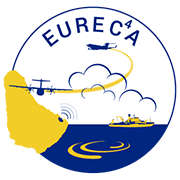28 Jan
First a very classic trade-wind sounding, which also illustrates the difference between the summer (NARVAL2) and the winter (NARVAL1). In the winter it is frequent to have a wind reversal between 4 and 6 km, something that is very pronounced in today’s 12Z sounding. Essentially what we see is that increasing surface SST gradients lead to more shear on average, and the westerlies lie above the easterlies with the boundary descending as one moves poleward. The layer of deep easterlies, that for instance we say during the summer has gone south for the season. This shear poses challenges for airmass characterization by the soundings that we plan during EUREC4A.
Well and the radar image shows something new! A stratiform layer near the trade inversion (look at the moist finger at the inversion at 800 hPa) and elevated cirrus in the moist layer near 900 hPa, with the differing directions of the wind evident in both. Pretty cool.


